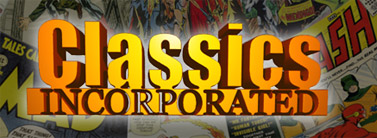GPA Article #2
Proposal For New Grading Categories
Last installment, we began discussing how the restored
comic market would benefit from an expansion of existing
categories, and a new set of grading standards that would
reflect quality of work. Currently there are only three
categories to judge the extent of restoration: slight,
moderate and extensive. A summary of each is below:
Slight - This is obviously the category closest to unrestored comics, and gets the most attention from collectors. It's important to make a distinction between amateur and professional restoration here (noted on CGC labels as "A" or "P"), because this information is used to determine whether the restoration can be reversed. This may also be where the top end of restored comics is ultimately established, particularly for the books that have only minor structural repairs, such as rice paper application for tear seals and support. Below are the restoration processes allowed in the slight category. Note which are considered amateur and professional.
- Cover cleaned -- professional
- Cover re-glossed -- amateur
- Color touch (a few hits on the spine or edges) - amateur or pro, depending on materials used
- Minor support or seals using glue -- amateur
- Minor support or seals using rice paper and adhesive -
professional
- Tiny piece replacement (bindary chips or a Marvel chip) -
usually professional
Moderate - This a narrow category, allowing only a small bit of wiggle room between slight and extensive. Because moderate restoration negates the possibility of removal, they are frequently ignored by high end buyers, and are subsequently the books that restoration collectors are attracted to.
- Color touch (along spine and edges, used for piece replacement)
- Small piece replacement (small and few in nature)
- Numerous support areas or tear seals
Extensive - The most abused of the three categories, extensive has become the "junkyard" for a lot of books because of the perception that every comic here was resurrected from the dead. According to current grading standards, the extensive category is extremely broad, encompassing anything from one sizeable piece replacement to complete reconstruction. The proposed expansion of categories should be focused here.
- Large piece replacement
- Color touch (large areas inpainted, whole areas recreated)
- Reconstructed interiors
- Recreated pages or parts of cover
Proposal For New Categories:
The new proposal for an expansion of these categories is
as follows:
- slight conservation
- slight restoration
- slight/moderate
- moderate
- moderate/extensive
- extensive
- qualified extensive
Slight Conservation - this encompasses only
archival treatment that preserves the comic for the future
without making aesthetic repairs. It includes tear seals and
support with rice paper, piece reattachment and
deacidifcation only. Because this work is reversible and is
the most universally accepted form of restoration, it has
the potential to establish a high end for restored comics. A
good example well represented by this category is the
Detective #27 app 6.0 that sold in the January 2006
Heritage auction. The book was virtually untouched, save
for minor spine support and a tear seal to the back cover.
It's one of the brightest copies I've seen in a while, and
will certainly rank among the best in the coming years.
Slight Restoration - very similar to slight
conservation, but includes minor aesthetic repair, such as
color touch, cleaning, minor piece fill and re-glossing.
There will also be the usual "pro" and "amateur"
designations, depending on what materials were used. Removal
is still a possibility in this category, which should
closely resemble the current standard for slightly restored
comics.
Slight/Moderate - Slightly restored comics that
barely fall into the moderate category due to a bit more
color touch, piece fill or support. A good example of this
is a comic that has had a full spine split (cover in two
pieces) sealed and the book reassembled. CGC currently
classifies this as moderate work because of the drastic
grade increase that results, even though a very small area
is actually being supported. Restoration removal would not
be feasible on most of these books.
Moderate - Will resemble the current category.
Moderate/Extensive - A very important addition to the
scale to distinguish between the borderline moderates and "frankenbooks".
The work performed on these comics is still relegated to
specific parts of the cover, instead of "paint jobs" and
huge piece fills that are associated with extensively
restored books. Most collectors of restored comics will
focus their efforts on slight/moderates, moderates and
moderate/extensives because they represent the best quality
in the market.
Extensive - Reserved for comics that have been
rebuilt from the ground up. There is nothing wrong with
these books at all; they have been saved from complete
degradation, and are now attractive enough to be
collectible. The extensive jobs will simply be a bargain,
compared to the other categories.
Qualified Extensive - This category will encompass
incomplete books with recreated parts, such as missing
pages, back cover, or masthead. I see this frequently, and
I'm not really sure how CGC grades them. Since these comics
are still technically incomplete, it's not fair to grade
them poor, and it's misleading to give them a high grade.
These books are unique, and deserve their own category to
allow a clear and honest establishment of market value.
Next installment will discuss incorporating a restoration
quality scale into the proposed standards. After that we'll
tie it all together and make suggestions on how it can be
best presented on the CGC label. |
